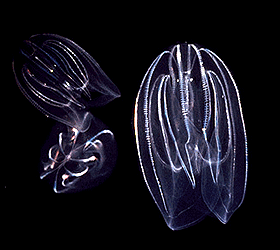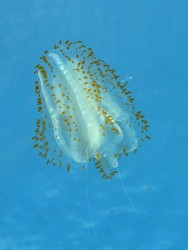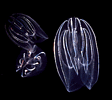Ctenophora
Comb jellies



This tree diagram shows the relationships between several groups of organisms.
The root of the current tree connects the organisms featured in this tree to their containing group and the rest of the Tree of Life. The basal branching point in the tree represents the ancestor of the other groups in the tree. This ancestor diversified over time into several descendent subgroups, which are represented as internal nodes and terminal taxa to the right.

You can click on the root to travel down the Tree of Life all the way to the root of all Life, and you can click on the names of descendent subgroups to travel up the Tree of Life all the way to individual species.
For more information on ToL tree formatting, please see Interpreting the Tree or Classification. To learn more about phylogenetic trees, please visit our Phylogenetic Biology pages.
close boxReferences
Carre, C. and D. Carre. 1989. Haeckelia bimaculata sp. nov., a new species of ctenophore (Cydippida, Haeckeliidae) from the Mediterranean with cnidocysts and pseudocolloblasts. Comptes Rendus de l'Academie des Sciences Serie III-Sciences De La Vie 308:321-327.
Carre, C. and D. Carre. 1993. Ctenella aurantia, new genus and new species of mediterranean tentacled ctenophore (Ctenellidae fam. nov.) without colloblasts, but with labial suckers. Canadian Journal of Zoology 71:1804-1810.
Costello, J. H. and R. Coverdale. 1998. Planktonic feeding and evolutionary significance of the lobate body plan within the ctenophora. Biological Bulletin 195:247-248.
Haddock, S. H. D. and J. F. Case. 1995. Not all ctenophores are bioluminescent: Pleurobrachia. Biological Bulletin 189:356-362.
Harbison, G. R. 1985. On the classification and evolution of the Ctenophora. Pages 78-100 in The Origins and Relationships of Lower Invertebrates. (S. C. Morris, J. D. George, R. Gibson and H. M. Platt, eds.). Oxford University Press, Oxford.
Harbison, G. R., L. P. Madin, and N. R. Swanberg. 1978. Natural history and distribution of oceanic ctenophores. Deep-Sea Research 25:233-256.
Harbison, G. R. and R. L. Miller. 1986. Not all ctenophores are hermaphrodites. Studies on the systematics, distribution, sexuality and development of two species of Ocyropsis. Marine Biology 90:413-424.
Martindale, M. Q. and J. Q. Henry. 1997. Ctenophora. Pages 87–115 in Embryology: Constructing the Organism. S. F. Gilbert and A. M. Raunio (eds.) Sinauer, Sunderland, MA.
Martindale, M. Q. and J. Q. Henry. 1999. Intracellular fate mapping in a basal metazoan, the ctenophore Mnemiopsis leidyi, reveals the origins of mesoderm and the existence of indeterminate cell lineages. Developmental Biology 214:243-257.
Matsumoto, G. I. and G. R. Harbison. 1993. In situ observations of foraging, feeding, and escape behavior in three orders of oceanic ctenophores: Lobata, Cestida, and Beroida. Marine Biology 117:279-287.
Mills, C.E. 1987. Revised classification of the genus Euplokamis Chun, 1880 (Ctenophora: Cydippida: Euplokamidae n. fam.), with a description of the new species Euplokamis dunlapae. Canadian Journal of Zoology, 65: 2661-2668.
Mills, C. E. 1987. Key to the phylum Ctenophora. Pages 79-81 in Marine Invertebrates of the Pacific Northwest. (E. N. Kozloff, ed.) University of Washington Press, Seattle.
Mills, C. E. and R. L. Miller. 1984. Ingestion of a medusae (Aegina citrea) by the nematocyst-containing ctenophore Haekelia rubra (formerly Euchlora rubra): phylogenetic implications. Marine Biology 78:215-221.
Mills, C. E., P. R. Pugh, G. R. Harbison, and S. H. D. Haddock. (1996) Medusae, siphonophores and ctenophores of the Alborán Sea, south western Mediterranean. Scientia Marina 60: 145-163.
Morris, S. C.and D. H. Collins. 1996. Middle cambrian ctenophores from the Stephen Formation, British Columbia, Canada. Philosophical Transactions of the Royal Society of London Series B 351:279-308.
Pianka, H. D. 1974. Ctenophora. Pages 201-265 in Reproduction of Marine Invertebrates, Volume I: Acoelomate and Pseudocoelomate Metazoans. (A. C. Giese and J. S. Pearse, eds.) Academic Press, New York.
Podar, M., S. H. D. Haddock, M. L. Sogin and G. R. Harbison. 2001. A molecular phylogenetic framework for the phylum Ctenophora using 18S rRNA genes. Molecular Phylogenetics and Evolution 21:218–230.
Stanley, G. D. and W. Stürmer. 1983. The first fossil ctenophore from the lower devonian of West Germany. Nature 303:518-520.
Stanley, G. D. and W. Stürmer. 1987. A new fossil ctenophore discovered by X-rays. Nature 328:61-63.
Information on the Internet
- Introduction to the Ctenophora. UCMP Berkeley.
- Phylum Ctenophora: list of all valid species names. Maintained by Claudia Mills.
- Comb Jellies. A micscape article by Wim van Egmond.
- The JelliesZone. A page about gelatinous zooplankton provided by David Wrobel.
- Steven Haddock's Pictures of Plankton. Ctenophores and more.
- The Photo Gallery of the Bioluminescence Web Page also has some great pictures of ctenophores.
- Ctenophora. Part of the Underwater Field Guide to Ross Island & McMurdo Sound, Antarctica.
- Ctenophora of the Black Sea. Part of the Biodiversity of the Black Sea Project. Institute of Biology of the Southern Seas, National Academy of Sciences of Ukraine.
Title Illustrations

| Scientific Name | Mnemiopsis |
|---|---|
| Acknowledgements | Photograph from Gray Museum Slide Collection |
| Copyright |
© 1995 Marine Biological Laboratory, Woods Hole

|
| Scientific Name | Leucothea pulchra |
|---|---|
| Location | Pebble Beach, California, USA |
| Specimen Condition | Live Specimen |
| Source | comb jelly |
| Source Collection | Flickr |
| Image Use |
 This media file is licensed under the Creative Commons Attribution-NonCommercial-NoDerivs License - Version 2.0. This media file is licensed under the Creative Commons Attribution-NonCommercial-NoDerivs License - Version 2.0.
|
| Copyright | © 2008 amy lemur |
About This Page
Page copyright © 1995
 Page: Tree of Life
Ctenophora. Comb jellies.
The TEXT of this page is licensed under the
Creative Commons Attribution-NonCommercial License - Version 3.0. Note that images and other media
featured on this page are each governed by their own license, and they may or may not be available
for reuse. Click on an image or a media link to access the media data window, which provides the
relevant licensing information. For the general terms and conditions of ToL material reuse and
redistribution, please see the Tree of Life Copyright
Policies.
Page: Tree of Life
Ctenophora. Comb jellies.
The TEXT of this page is licensed under the
Creative Commons Attribution-NonCommercial License - Version 3.0. Note that images and other media
featured on this page are each governed by their own license, and they may or may not be available
for reuse. Click on an image or a media link to access the media data window, which provides the
relevant licensing information. For the general terms and conditions of ToL material reuse and
redistribution, please see the Tree of Life Copyright
Policies.
Citing this page:
Tree of Life Web Project. 1995. Ctenophora. Comb jellies. Version 01 January 1995 (temporary). http://tolweb.org/Ctenophora/2462/1995.01.01 in The Tree of Life Web Project, http://tolweb.org/









 Go to quick links
Go to quick search
Go to navigation for this section of the ToL site
Go to detailed links for the ToL site
Go to quick links
Go to quick search
Go to navigation for this section of the ToL site
Go to detailed links for the ToL site